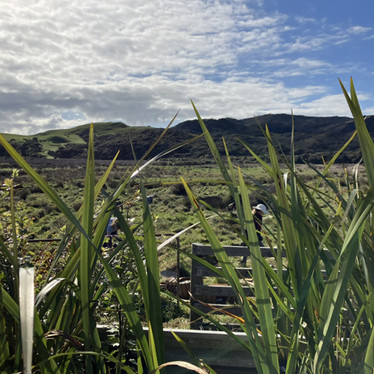
The HealthPost Nature Trust is currently focused on restoring the Wharariki Wetland as part of its partnership work to regenerate biodiversity at Onetahua Farewell Spit.
Wetlands are crucially important for biodiversity. Supporting great concentrations of life, these highly sensitive environments are vital for the survival of many of our endangered plants and threatened bird and fish species. Wetlands also play an important role in improving water quality and buffering the impacts of flooding and periods of lower rainfall.
The Wharariki Wetland is only a short hop from the 3-hectare predator proof Wharariki Ecosanctuary at Cape Farewell, the hub for HealthPost Nature Trust seabird reintroduction efforts. Through extending revegetation and predator control efforts, the Nature Trust is working to create a safe corridor for native species extending from the spectacular coastline to the forested hills. The Wharariki Wetland is both an important step toward this vision, and a precious ecosystem in its own right.

Nature Trust Coordinator Marian Milne brings the significance of this project to life:
“It’s a good reminder of the changing focus of our times. Not so long ago this area was prized summer grazing with huge effort going in to put in drains and control rushes!
The Wharariki wetland is now listed as one of the most significant wetlands for restoration in the top of the south. Fernbirds are already doing well in the area and we are still hopeful to reintroduce pateke-brown teal. Mostly unseen are the eels and various fishes and a gazillion invertebrates. The occasional bittern spotted in the area maybe will come back one day to breed and the food resource for our forest birds such as kereru, kaka and tui may see the return of these birds in numbers to feast on flaxes, coprosma and kahikatea.
Wetland plantings from the last three years are doing well on the SE side of the Cape Farewell turnoff. Take time to check them out and be prepared for a slow but steady transformation.”
The recent ‘retiring’ of another 10 hectares of grazing brings the wetland area being restored to around 30 hectares. The Wharariki wetland is visible on the road to the popular Wharariki beach, so thousands of visitors each year will be able to see this conservation project in action.
Successful community volunteering days in late August saw another 900 trees planted in the wetland, a mix of carex, cabbage trees, manuka, caprosma, pittosporum and kaihikatea, with more podocarps such rimu, miro and matai to follow in coming years. Previous plantings by the Nature Trust crew and the HealthPost team have already put 3500 trees in the wetland, so the transformation has begun!
Here’s some photos of the keen volunteer planting crew - myself included - putting in some very healthy plants in perfect conditions, powered by Marian’s signature carrot cake! As if restoring a wetland in an iconic part of Aotearoa on a glorious day isn’t rewarding enough ;)

| Discover the HealthPost Nature Trust→ | HealthPost Nature Trust T-Shirts→ |

